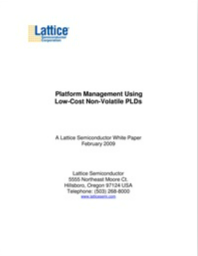Platform Management Using Low-Cost Non-Volatile PLDs
Power-up control, general purpose I/O expansion, voltage level translation and interface bridging are common functions in telecom infrastructure, server and industrial applications. System designers are turning to the use of programmable logic devices (PLDs) to implement these functions in their designs due to the inherent time-to-market and design flexibility advantages they offer over ASICs and ASSPs.
By using PLDs in their designs, designers can respond to changing market standards and requirements within a compressed window of opportunity.
Download this whitepaper to find out more.
Read More
By submitting this form you agree to Lattice Semiconductor Corporation contacting you with marketing-related emails or by telephone. You may unsubscribe at any time. Lattice Semiconductor Corporation web sites and communications are subject to their Privacy Notice.
By requesting this resource you agree to our terms of use. All data is protected by our Privacy Notice. If you have any further questions please email dataprotection@techpublishhub.com
Related Categories: Automotive, Communication, Components, Embedded, Industrial, Power, Switches

More resources from Lattice Semiconductor Corporation
RELIABLE RESET GENERATION FOR TI TMS320C6XXX (“DAVINCI”) PROCESSORS
Every microprocessor or DSP requires a reset generator circuit or IC to perform two functions: (1) start up from a fixed condition after the suppli...
MachXO PLDs in System Control Designs
Temperature measurement, current monitoring, power supply sequencing, fan control and fault logging are typical board control functions used in com...
MachXO™: Optimized Programmable Devices for Bus Interfaces, Bridges and Control
Bus bridging, interfacing and control are common functions in many electronic systems. The use of these functions spans virtually every end market ...
